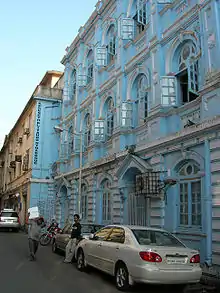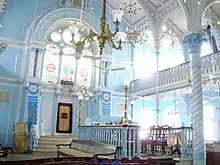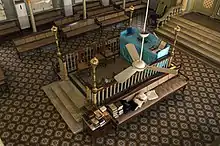| Knesset Eliyahoo בית הכנסת אליהו | |
|---|---|
 Exterior of Knesset Eliyahoo Synagogue | |
| Religion | |
| Affiliation | Orthodox Judaism |
| Rite | Sephardic |
| Ecclesiastical or organizational status | Active |
| Location | |
| Location | Kala Ghoda, Mumbai |
| State | Maharashtra |
| Country | India |
| Geographic coordinates | 18°55′41″N 72°49′57″E / 18.928114952632427°N 72.83257376854603°E |
| Architecture | |
| Architect(s) | Gostling & Morris |
| Completed | 1884 |
The Knesset Eliyahoo, also Knesset Eliyahu, is an Orthodox Jewish synagogue located in downtown Mumbai, India. It is the city's second oldest Sephardic synagogue. It was established in 1884 by Jacob Elias Sassoon, son of Eliyahoo David Sassoon and grandson of David Sassoon;[1] the latter had immigrated from Baghdad to India in 1832 due to persecution and had settled in Mumbai, then known as Bombay. It is maintained by the Jacob Sassoon Trust. The building's significance is attributed to its Jewish traditions as well as Indian and English colonial influences.
It was designed by the British architectural firm Gostling & Morris of Bombay.[2] The basement part of the edifice is built in stone masonry and the superstructure is built in brick masonry. The exterior facade of the synagogue is painted turquoise. The sanctuary within the interior of the building is in western direction, towards Jerusalem.
Location
Knesset Eliyahoo, an Orthodox Jewish synagogue, the second oldest Sephardic, is located in Colaba at 55, Dr. V.B. Gandhi Marg, Fort, Mumbai. The Taj Mahal Palace Hotel, and Oberoi Trident are nearby.[3][4]
Background

Prior to the arrival of Baghdadi Jews in India, the Jews residing in Bombay — the name then used for Mumbai — had settled in the towns of India, living peacefully with other communities in India.[5][6] Harry D. Wall, in an interview to the New York Times, has said that among the Jews who now remain in Mumbai are a group of Jews known as Bene Jews or Bene Israel who were reportedly descendants of seven tribes of Israel who, in the 2nd century BC, were shipwrecked on India's Konkan coast while escaping persecution in the Galilee.[5][7] They found that living in India, amidst a cosmopolitan community consisting of Hindus, Buddhists, Jains, and, much later, Muslims, was a very cordial environment, totally free of anti-Semitic feelings.[5][6]
The Jewish merchant community, which played a significant role in the commercial development of then Bombay (now Mumbai), consisted of Jews from Iraq, Syria, and other Middle Eastern countries who immigrated in the late 18th century under the threat of persecution. They found the environment conducive to continuing their trade and settled in the city, becoming prosperous in business ventures such as textile mills and international trading.[5][6] In 1784, the British government took over the East India Company. With this change, many business opportunities emerged in India, and Bombay in particular, encouraging immigrants to set up businesses. In 1790, one such business magnate was Shalom ben Ovadiah HaCohen, a Baghdadi Jew who had migrated from Aleppo (Halab), in Syria to Bombay; other Jewish businessmen from Baghdad, Basra, and Yemen followed him.[8]
History



In 1832, David Sassoon immigrated to Bombay and established himself as a magistrate of the cotton industry. He built the Magen David Synagogue in Byculla. Mumbai in 1864; this was in addition to the older Magen Hasidim synagogue. His son, Albert Sassoon, transformed the weaving industry in Bombay.[7][8] To cater to the increasing need of the Baghdadi Jews, Knesset Eliyahoo synagogue was constructed on a premium piece of land in the hub of Bombay's commercial area by Jacob Sassoon, grandson of David Sassoon, commemorating his father, Eliyahoo Sassoon. It was established in 1884.[6][9]
More Jews came from Bukhara, Persia, and, following the Farhud pogrom in Iraq in 1941, many more immigrants shifted to Bombay. They all used to assemble in the Knesset Eliyahoo synagogue in large numbers during festival days and on Rosh Hashana and Yom Kippur. On many such occasions, in view of the large crowd of devotees, overflow prayer services were held in the neighbouring Cawasjee Jehangir Public Hall.[9]
In 1985, President Giani Zail Singh visited the site to honour the centennial of the synagogue's construction. India Post issued a commemorative stamp in honour of the centennial.[10]
The first-ever terrorist attack on Jews in Mumbai occurred on 26 November 2008. Rabbi Gavriel Holtzberg, who had conducted Sabbath services on the previous day and also held religious discourses at the Knesset Eliyahoo, was killed, along with his wife and a few other Jews at the Nariman House, a community center operated by Chabad. This sowed fear among the Jewish community members residing in Mumbai, and also forged a closer bond between the city's Baghdadi and Bene Israel Jews.[6]
Architecture and fittings
Designed by the British architectural firm Gostling & Morris of Bombay,[3] the building's base is of stone masonry while the superstructure is of brick masonry.[9] The external frontage of the synagogue is painted turquoise, and the synagogue is popularly known as the Blue Synagogue of Mumbai.[6] The synagogue was not originally blue. The synagogue was returned to its original colour of white, with bright indigo boarders during a restoration process in 2018 - 19 carried out by conservation architect Abha Narain Lambah.[1][11]
The inner space contains ornamented pillars, and the sanctuary faces west towards Jerusalem. The bimah (reader's platform) is bordered on both sides by ornately carved marble, over which is placed a tall, stained-glass arch that reaches the ceiling. Women worshippers sit in an upstairs gallery. The synagogue contains a number of Torah scrolls, along with silver-cased sefarim (religious books) belonging to the Sassoon family. On the ground floor, there are meeting and school rooms, and a mikveh (immersion pool).[9] The staircase, windows, timber balconies, ceiling, walls, and roof are in need of restoration.[3]
Gallery
 Exterior of Knesset Eliyahoo Synagogue after restoration in 2019
Exterior of Knesset Eliyahoo Synagogue after restoration in 2019 Exterior of Knesset Eliyahoo
Exterior of Knesset Eliyahoo
See also
References
- 1 2 Datta, Rangan (3 October 2020). "Inside the synagogues of Mumbai". Archived from the original on 28 January 2021. Retrieved 21 January 2021.
- ↑ "Mumbai's iconic 'blue' Knesset Eliyahoo Synagogue open to public, after year-long restoration". Firstpost. 10 February 2019. Archived from the original on 14 July 2022. Retrieved 14 July 2022.
- 1 2 3 "Keneseth Eliyahoo Synagogue". World Monuments Fund. Archived from the original on 29 May 2015. Retrieved 23 May 2015.
- ↑ "Keneseth Eliyahoo Synagogue, Mumbai, India". Sir Jacob Sassoon Synagogues and Allied Trusts. Archived from the original on 29 May 2015. Retrieved 23 May 2015.
- 1 2 3 4 Birnbaum 2010, pp. 325–26.
- 1 2 3 4 5 6 Khan, Jeremy (2 December 2008). "Jews of Mumbai, a Tiny and Eclectic Group, Suddenly Reconsider Their Serene Existence". The New York Times. Archived from the original on 22 February 2019. Retrieved 25 February 2017.
- 1 2 Brennan, Emily (16 September 2014). "Exploring the World's Jewish Communities". The New York Times. Archived from the original on 25 July 2018. Retrieved 25 February 2017.
- 1 2 Dana 2007, p. 88.
- 1 2 3 4 "Baghdadian Synagogues in Mumbai (Bombay) & Poona (Pune)". The Keneseth Eliyahoo Synagogue. Midrash Organization. Archived from the original on 25 July 2018. Retrieved 22 May 2015.
- ↑ Dana 2007, p. 89.
- ↑ "Little-known facts about Mumbai's newly restored Keneseth Eliyahoo synagogue - Elle India". Archived from the original on 14 July 2022. Retrieved 14 July 2022.
Further reading
- "Mumbaiwale: Agog over a synagogue". Hindustan Times. 9 February 2019.
- Birnbaum, David (2010). Jews, Church & Civilization, Volume VII. David Birnbaum. GGKEY:79ST9DTYU28.
- Dana, Leo Paul (2007). Asian Models of Entrepreneurship: From the Indian Union and the Kingdom of Nepal to the Japanese Archipelago : Context, Policy and Practice. World Scientific. ISBN 978-981-256-878-6.